‘Azerbaijan- A Land of Natural Wonders’ is what we would love to entitle this country to. It is difficult to describe the beauty and charm of this country. Recently, it has emerged as a popular tourist destination, but the wonders date back several centuries. This country has an incredible history of its own that makes it a natural wonder and attracts tourists.
Azerbaijan’s location adds another dimension to its popularity, and visiting during the best time adds a feather to the hat. Located at the crossroads of Europe and Asia, this country has influences of both Asian and European origins.
Most Asian people love visiting here because of its Asian essence and European architecture. But before planning the Azerbaijan itinerary, let’s understand its geographical features.
Azerbaijan can be vaguely divided into 3 geographical types,
- The Caspian Sea which forms a natural boundary to the east.
- The Extensive Flatland at the country’s centre.
- The Greater Caucasus is the mountain range to the north.
Azerbaijan has a wide range of landscapes, from mountain ranges, crests, seas, rivers, lakes and highlands to plateaus. It provides a unique travel experience because of its rich culture, mesmerising architecture, natural beauty, incredible history, clean cobblestone streets, cuisine, events, and hospitality. So, what’s next? Let’s plan your Azerbaijan itinerary. But beforehand, check out the list of the best places to visit in Azerbaijan.
[Note: To enjoy to the fullest, plan your Azerbaijan itinerary for 7 days, but if you want a 5-day Azerbaijan itinerary, you can also contact our travel experts for customisation].
Day 1 of Azerbaijan Itinerary: Explore the Icheri Sheher of Baku
After landing at your dream destination, check into your hotel and get ready for the upcoming fun. On the first day in Azerbaijan, it is always better to explore the Icheri Sheher (Old City of Baku), which gives you insights into the country’s history.
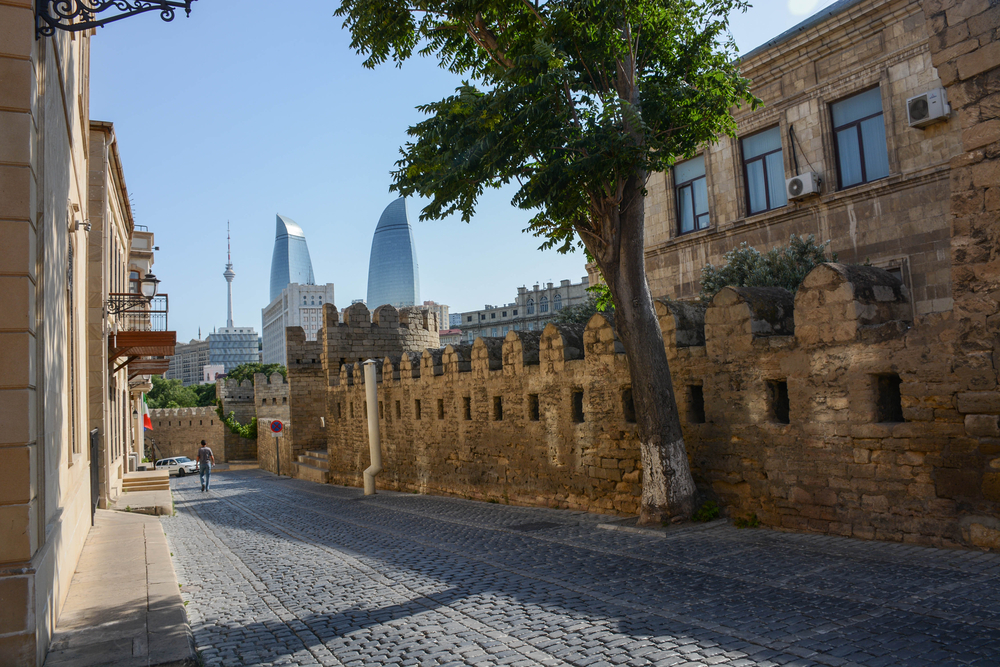
Icheri Sheher is surrounded by medieval castles, walls, clean, narrow cobblestone streets, and ancient buildings and shops to visit. This city can help you understand the history of Azerbaijan. It became a historical reserve in 1977 and was declared a UNESCO World Heritage Site in 2000. Take an entire day to explore the beautiful attractions, such as:
Maiden Tower (Giz Galasi):
This iconic cylindrical structure is one of Baku’s most famous landmarks, with origins dating back to the 12th century. Though its origin is mysterious but it is believed to be a fortress built by a king, from which a maiden committed suicide as she was unwilling to get married.
Shirvanshahs’ Palace:
An incredible example of medieval Azerbaijani architecture, which includes the royal residence, a mosque, and a mausoleum, reflecting the grandeur of the Shirvanshahs dynasty that ruled in the region during the 15th century.
Muhammad Mosque:
It is one of Baku’s oldest mosques, renowned for its impressive 19th-century architecture.
Karabakh Khan’s Palace:
This palace represents the grace of Azerbaijani architecture and offers a glimpse into the lifestyle of the regional rulers during the pre-Russian era.
Miniature Book Museum:
This unique museum highlights the extraordinary collection of miniature books, some as small as a grain of rice, reflecting the rich literary heritage of Azerbaijan and the art of miniature bookbinding.
Nizami Museum of Literature:
This museum is dedicated to the famous Azerbaijani poet Nizami Ganjavi which celebrates his literary works and their profound influence on Persian and Azerbaijani culture.
National Museum of History of Azerbaijan:
It is one of the largest museums in the country. Its diverse collection of artefacts and exhibitions provides an insight into Azerbaijan’s history, from ancient to modern times.
Taza Bazaar:
It is a must-visit market that offers a sensory experience with its fresh produce, spices, and traditional Azerbaijani foods.
Ancient Bathhouses:
These are ancient, historical bathhouses that showcase traditional Azerbaijani bath culture. They have unique architectural elements like domed ceilings and intricate tile work.
On the first day, explore the beautiful cafes, souvenir shops, and local wine shops and have fun. Then, try a traditional Azerbaijani dinner in a cosy local restaurant, return to your hotel and get a good night’s sleep.
Day 2 of Azerbaijan Itinerary: A Walk through the Azerbaijan’s Heart-Baku
Good Morning is incomplete if you miss the sunrise! For a great morning, wake up a little early and take a morning walk or jog towards Baku Boulevard for a beautiful sunrise🌅. It is the National Park of Baku (a beautiful promenade), which gives you the opportunity to breathe fresh air while jogging on the cleanest roads. Enjoy the sunrise view on the Caspian Sea🌊.

Baku Boulevard is a beautiful neighbourhood that has everything under one building🏢
- An amusement park🎡
- Sports complex🏓🏑
- Official complex
- Hypermart🛒
- Cinema📽️
Finish your breakfast and head straight to Heydar Aliyev Cultural Center to learn about the history, culture, and contemporary art of Azerbaijan. You must have seen the iconic white-coloured, fluid, wavy-shaped landmark, which is the Heydar Aliyev Cultural Centre.
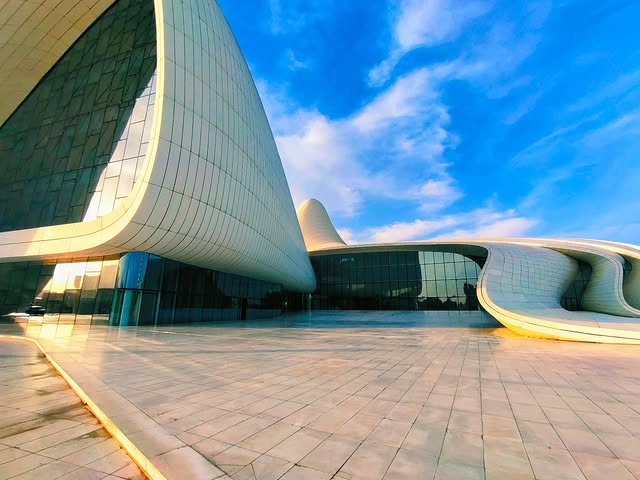
It has many things for tourists to explore inside it, such as
- Heydar Aliyev Museum
- Music Display
- Doll Collection
- Classic Car Museum
After some informative exploration, it’s time to enjoy the beauty of Baku’s Fountain Square. Parapet or Fountain Square is named because of the many beautiful fountains in this area. It stretches from Istiglaliyyat Street and Nizami Street to the eastern walls of Icheri Sheher.
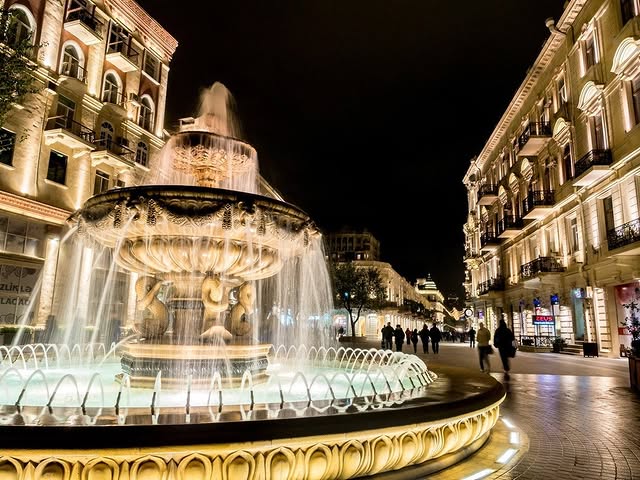
Tourists get mesmerised wandering in the beautiful, clean, cobblestone streets with many benches and realistic statues or figurines. This area has many coffee shops☕, restaurants🍲, bistros and bars🍻 lined in this street. So, it is an excellent neighbourhood to roam, shop and eat.
Day 3 of Azerbaijan Itinerary: Explore the Natural Wonders
New Day, New Exploration! Wake up with extra energy for a full day of adventurous exploration. Have your breakfast early and leave around 8 a.m. to visit Gobustan Rock Art, which is 66.8 km and takes around 1 hour and 5 minutes from Baku.
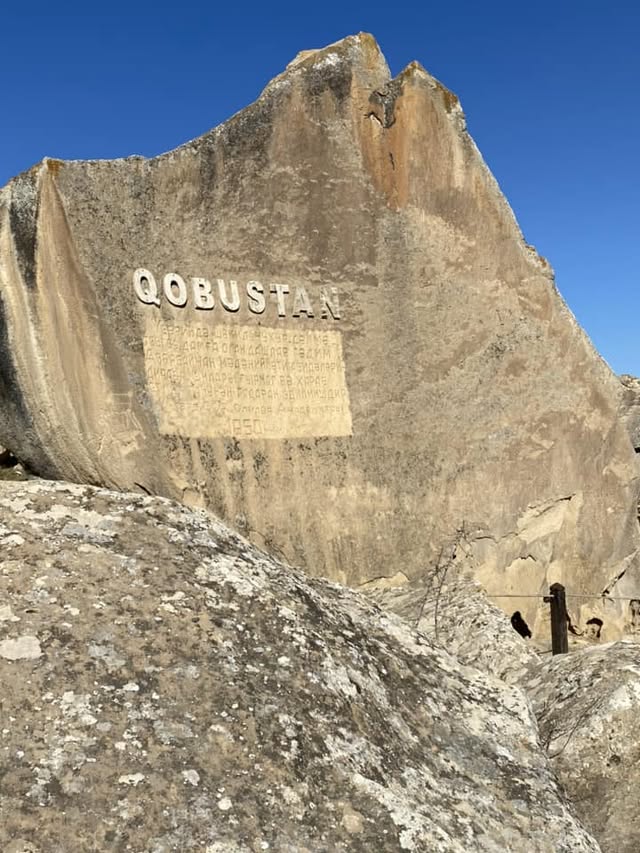
Gobustan Rock Art is a unique archaeological site. It houses a collection of thousands of ancient rock carvings and paintings dating back to the Stone Age, which illustrates men, ritual dances, men with lances in their hands, animals, bullfights, camel caravans, and pictures of the sun and stars. It opens at 9 p.m. on weekends and 10 a.m. on weekdays.
After exploring humankind’s history in Eurasia from the Upper Paleolithic period to the Middle Ages in Gobustan Rock Art, head to the next stop, i.e., Mud Volcano. 🌋
Mud Volcanoes🌋 are formed when the tectonic plates collide, and they erupt clay because of carbohydrogen. It is located in Gobustan National Park. It is more than just an adventurous visit; it’s also an opportunity to experience the healing power of volcanic mud🌋.
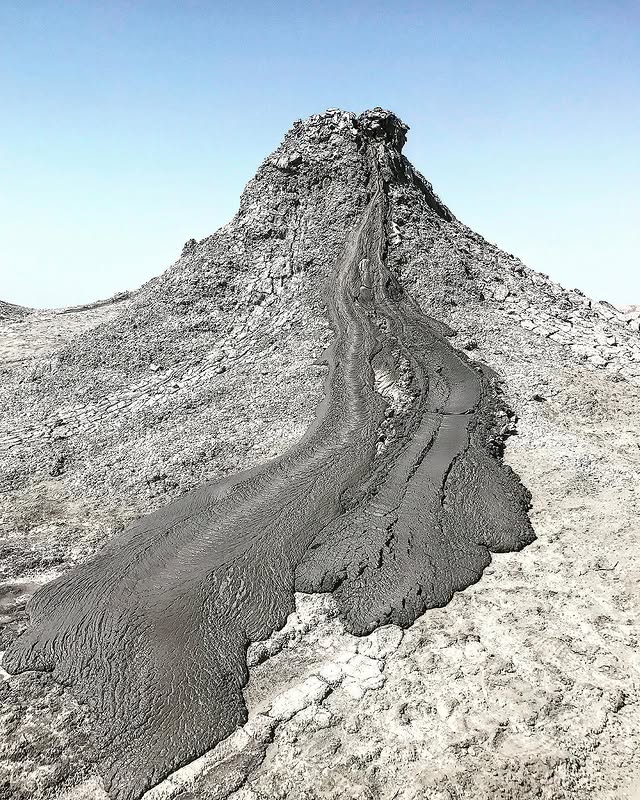
Mud volcanoes🌋comprise about half of the world’s total and provide a rare chance to immerse yourself in therapeutic mud baths that have been celebrated for centuries. Unlike traditional volcanoes, which erupt with lava, these mud volcanoes🌋 gently release mineral-rich mud and gas, creating small craters that add to the otherworldly charm of the landscape.
The mud itself is packed with minerals known to offer a range of therapeutic health benefits, such as
- Detoxifies Your Body: The mud helps remove toxins from your skin and body’s pores, promoting a natural cleanse.
- Relieves Joint and Body Pain: The mud’s natural properties can help reduce inflammation and provide relief from conditions like arthritis or muscle stiffness.
- Softens Your Skin: The minerals in the volcanic mud can help exfoliate and soften your skin. After a soak, your skin feels smoother, more hydrated, and renewed, like a natural mini spa treatment.
- Provides Relaxation: Beyond the physical benefits, a mud bath brings deep relaxation.
After a refreshing mud bath, head straight to the Atasgah Zoroastrian Fire Temple🔥. The exciting thing about this Fire🔥 Temple is that natural gas fires have been burning for centuries, and they don’t stop in the case of rainfall or snowfall.
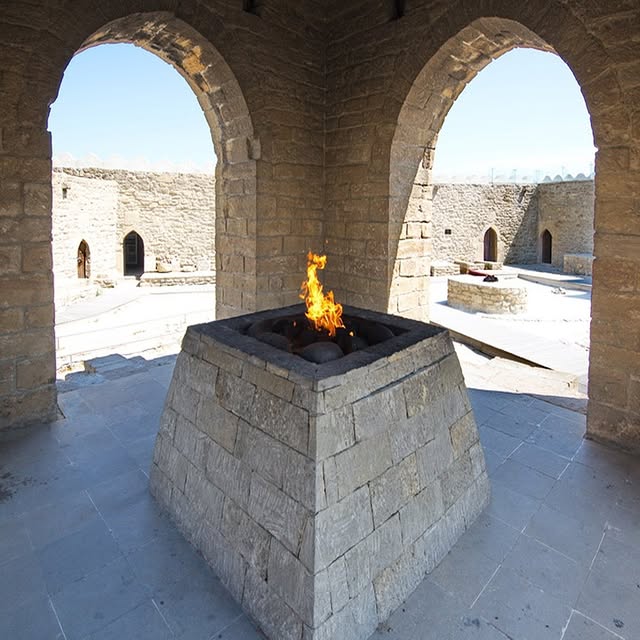
For the people of Azerbaijan, fire🔥is a symbol of divine light. They worship it in their Zoroastrian religion and culture. The Atashgah Zoroastrian Fire Temple🔥 also has a museum that provides insights into Zoroastrian beliefs, rituals, and the temple’s history. So, after exploring these natural wonders, end your day with a bag full of knowledge.
Day 4 of Azerbaijan Itinerary: A Day on Nature’s Lap
Pack your bags for an adventurous day at a mountain resort. In Azerbaijan, the two most popular resorts are Tufandag Mountain Resort and Shahdag Mountain Resort. Imagine enjoying outdoor activities amid nature- it sounds fun, doesn’t it? Let’s learn about the popular resorts to decide which one to pick for day 5 of the Azerbaijan itinerary.
Tufandag Mountain Resort:
Tufandag Mountain Resort is the highest peak in Gabala. It is 218.5 km and takes around 3 hours and 49 minutes to reach from Baku. It offers many activities, making it a year-round destination for locals and tourists.
For hikers and nature lovers, Tufandag has become a popular destination during summer. And during winter, it attracts skiers and snowboarders. Tufandag Mountain Resort offers various trails for all skill levels, ski rentals and lessons for newcomers.
The activities that Tufandag Mountain Resort offers are-
- Rope Line
- Quad Bike Tours
- Hiking
- Mountain Swing
- View Point
To know more about it, check the official website of Tufandag Mountain Resort.
Shahdag Mountain Resort:
Shahdag Mountain Resort calls for adventurous people who are ready to experience thrills to the extreme. It is 233.4 km and takes around 2 hours and 56 minutes from Baku. Staying in a beautiful mountain resort and enjoying nature is a blessing. This mountain resort offers various recreational amenities, including spas, swimming pools, and family entertainment options.
During snowfall, Shahdag Mountain Resort becomes a paradise for skiing and snowboarding enthusiasts. And during summer, it becomes a hotspot for hikers and mountain bikers, with picturesque trails offering sensational views.
Activities for adults in Shahdag Mountain Resort – Zipline, Paragliding, Buggy Rides, Off-road Rides, Paintball, Shooting, Horseback Riding, Polaris Tour, Archery, Trekking, Catapult, VR Zone, Tubing, Shahdag Coaster, Segway, Motocross, Mountain Swing
Activities for Children in Shahdag Mountain Resort – Adventure Park, Quad Tours, Kids Karting, Electric Car
To know more about it, check the official website of Shahdag Mountain Resort.
We hope you have decided which mountain resort to choose for your one-day tour of Baku. You can also stay there to enjoy the ultimate pleasure of nature, which makes it the best natural retreat in Azerbaijan.
Day 5 of Azerbaijan Itinerary: Experience Azerbaijan’s Royalty
Get ready to experience Azerbaijan’s rich heritage by exploring the royal palaces. With its beautiful European architecture, Azerbaijan is surely going to steal your heart. So, start with The Palace of Shaki Khans.
The Palace of Shaki Khans is the summer palace of the king. If you want to explore what royalty looks like, you must visit this summer palace. Describing the beauty that the eyes behold is very difficult.
It was built in the late 18th century, but it can stun people even of this generation with its exquisite “Shebeke” windows🪟, which highlight colourful🎨 geometric patterns that allow light to filter through in a captivating manner.
Words cannot do justice to the intricate design features of beautiful stained glass windows, ornate tile work, and detailed wood carvings. The Palace of Shaki Khans is a UNESCO World Heritage Site, making it a must-see destination on the Azerbaijan itinerary.
The Palace of the Shirvanshahs reflects medieval architecture. It is a remarkable historical complex built by the Kings of Shirvanshahs during the 15th century. It was used as a royal residence, administrative centre and place of worship. The intricately carved walls and ornate ceilings inside the structures provide a glimpse into the king’s luxurious lifestyle.
The Palace of the Shirvanshahs includes:
- Main Palace
- Mausoleum
- Mosque
- Bathhouse
After exploring the royal palaces, spend your early evening in Matyr’s Lane. This memorial site in Baku is dedicated to the memory of the soldiers and people who lost their lives in the Nagorno-Karabakh conflict. You can spot the Eternal Flame there, which acts as a symbol of hope and resilience.
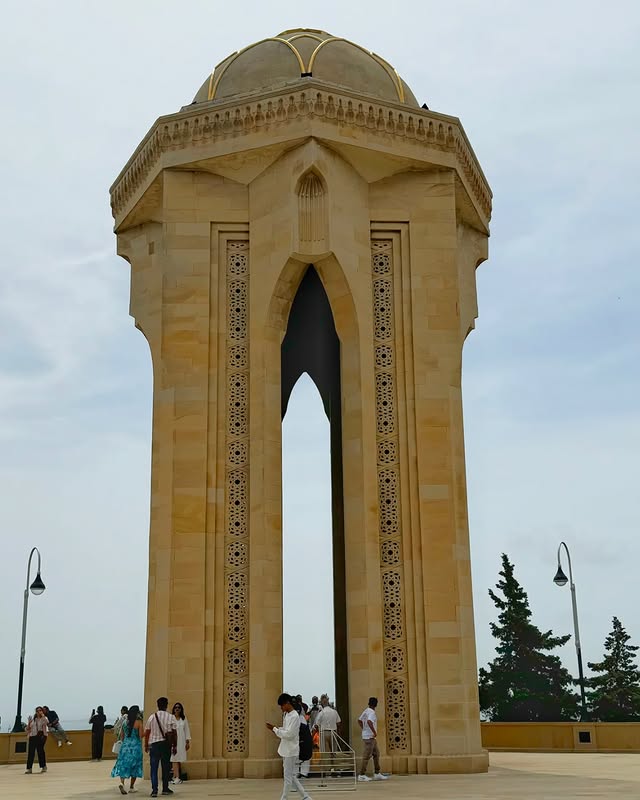
After exploring the charm of royal palaces, head straight to Highland Park for a calm, peaceful evening. It is the highest point in Baku, offering an aerial view of the entire city. Sometimes, it is important to take a pause from busy exploration and enjoy and appreciate the beauty from the top of the town, which gives a unique perspective of the city.
Highland Park is a clean, well-maintained garden with walking paths, stairs and benches. You can take a walk or just simply relax on benches and view the neighbouring Baku’s tourist attractions and iconic landmarks, such as
- Baku Boulevard
- Flame Towers
- Baku Bay
- The Old City of Baku
- The Maiden’s Tower
- The Shirvanshahs Palace
Then, if you feel like checking out the Flame Towers from close, it is better to visit once as it is one of the iconic landmarks of Azerbaijan.
As you know, fire is the symbol of the Zoroastrian religion; you can find many monuments representing eternal fire. So does the Flame Towers, which are the three skyscrapers shaped like flames.
The real beauty of the Flame Towers can be experienced during the night when 10,000 LED screens create a mesmerising display of moving flames and Azerbaijan’s National Flag.
Flame Towers stand 140 meters high and can be seen from different vantage points. Each tower has a similar structure but serves different functions.
- It has a residential tower with 130 residential apartments over 39 floors.
- A hotel situated in the northern corner has 250 rooms and 61 serviced apartments on 33 floors.
- The office tower is on the western side with a net of 33.114 square metres of commercial space.
- Retail podium offering leisure and retail facilities.
- Atrium has three levels of entertainment stops, including boutique shops, restaurants and a cinema.
We know this heart is stealing your heart with its incredible European architecture and modern infrastructure. But wait, there’s more to witness on day 5 of Azerbaijan itinerary.
Day 6 of Azerbaijan Itinerary: Explore the Local Azerbaijan
The beauty of authentic Azerbaijan can be found in its villages. If you want to experience it, you must visit two popular villages: Ganja Village or Lahij Village or Sheki.
Lahij Village:
About 170.8 km away and a 3-hour drive from Baku, through a breathtaking canyon, lies the charming village of Lahij. It is a peaceful place where time seems to slow down. As you wander through its antique cobbled streets, you will be captivated by the stone houses, unique souvenir shops, and the village’s rich cultural heritage.
Lahij Village has a history stretching back over 2,000 years. It has long been a hub of craftsmanship, and today, it’s a living historical and cultural reserve. More than 40 different crafts were practised here in the past, from hat-making and leatherwork to blacksmithing and carpet weaving. But Lahij is perhaps best known for its exquisite copperware, which was renowned throughout the Caucasus centuries ago.
Today, these beautifully crafted items can be found in some of the world’s top museums, reflecting the village’s long standing image for quality and artistry. The people of Lahij are ethnic Tats, and their distinct language and unique cuisine add a special touch to the village’s appeal.
It is worth taking the time to try some local dishes. The cool mountain air makes Lahij an especially pleasant escape in the summer, and the surrounding mountains offer a variety of scenic hiking routes for those looking to explore the great outdoors.
Things to explore in Lahij Village-
- Copperware Workshops
- Antique Cobblestone Streets
- Lahij Handicraft Shops
- Historical Sites
- Lahij’s Local Cuisine
- Hat-making and Leather Crafting
- Scenic Mountain Hiking
- Local Museums and Cultural Centers
- Blacksmithing Workshops
- Village Festivals and Events
Sheki:
Sheki is one of Azerbaijan’s most charming and historically rich cities. It is located in the foothills of the Greater Caucasus Mountains, 362.7 km from Baku, and takes about 4-5 hours to drive. Known for its stunning natural beauty, centuries-old architecture, and rich cultural heritage, Sheki offers a peaceful escape from the hustle and bustle of the capital.
Sheki has beautiful examples of traditional Azerbaijani architecture, particularly its charming caravanserais and ancient mosques. The buildings are often made of stone and feature intricate wooden carvings and colourful tiles, reflecting local and Islamic influences.
The top attractions to visit in Sheki are:
Sheki Khan’s Palace (Sheki Khansaray):
Dating back to the 18th century, it is famous for its breathtaking stained glass windows (known as “shebeke”) and intricate frescoes. The palace’s exquisite architecture and elaborate design showcase the luxury of the Sheki Khans, who once ruled the region. The palace is surrounded by lush gardens, offering a serene setting for visitors.
Sheki Caravanserai:
Located in the city’s heart, the Sheki Caravanserai is a well-preserved 18th-century inn that was once a stopover or halting place for traders along the Silk Road. Today, it serves as a cultural and tourist centre, offering local handicrafts and souvenirs. Its highlighting part is the grand structure, with its high arched ceilings and vast courtyard.
Gelersen-Gorersen Fortress:
Located on a hill overlooking Sheki, this ancient fortress from the medieval period offers mesmerising views of the city and the surrounding valley. Tourists can hike up to the site and explore the ruins of what was once a fortified stronghold.
The Upper and Lower Caravanserais:
Sheki is home to two caravanserais: the Upper and Lower Caravanserais. These historic buildings were once resting places for traders along the Silk Road. The Upper Caravanserai has been beautifully restored and is now home to various shops selling local handicrafts, including pottery, textiles, and carpets.
The Sheki Museum of History and Local Lore:
This museum provides insight into the region’s long history, culture, archaeology, and art from ancient times through the Soviet period.
Kish Village:
Just a short drive from Sheki, the village of Kish is home to the ancient Kish Albanian Church. This church, built in the 12th century, is one of the oldest Christian monuments in the region. The village is set against the backdrop of rolling hills, making it a peaceful and scenic place to visit.
Sheki’s Famous Bathhouses:
Tourists can find traditional bathhouses. Some of these old-style baths still operate today, offering visitors a relaxing experience with natural mineral-rich water and a taste of Azerbaijani spa culture.
Things to do in Sheki, Azerbaijan
- Try Sheki’s local delicacies: Sheki Kebab, Piti (a slow-cooked stew), Sheki Pakhlava (a traditional Azerbaijani pastry) and Sheki Halva, a sweet and nutty treat.
- Explore Sheki’s Local Markets and buy fresh produce, local spices, handmade goods, and traditional Azerbaijani sweets and dried fruits.
- Buy Sheki’s Local Handicrafts and Silk Products like silk carpets, traditional fabrics, and textiles.
Ganja:
Ganja is the second-largest city in Azerbaijan. It is a historically significant destination located in the western part of the country. Located 359.8 km, about 4-5 hours’ drive from Baku, it is known for its cultural heritage, beautiful parks, and proximity to natural wonders.
Ganja is often referred to as the “City of Rivers” due to its location along the flow of the Ganja River. It is also the birthplace of some of Azerbaijan’s most important historical figures.
Javad Khan Street and City Center:
Javad Khan Street is named after the last ruler of Ganja. It is a street lined with historical buildings, restaurants, and cafes. The area around Khan’s Garden and Nizami Square is charming for taking a walk, with lovely fountains and a relaxed atmosphere.
Nizami Mausoleum:
This museum is dedicated to the 12th-century Persian poet and philosopher Nizami Ganjavi, born in Ganja. He is known for his romantic epics and philosophical works, which are a cornerstone of Persian literature. The museum showcases his life and literary legacy.
Javad Khan Mausoleum:
This mausoleum honours Javad Khan (the last ruler of Ganja before the Russian Empire annexed the region). Javad Khan fought valiantly against Russian forces in the early 19th century but was eventually captured. The mausoleum, located near the Ganja Fortress, stands as a tribute to his role in Ganja’s history.
Ganja Fortress:
This ancient structure, also known as Javad Khan Fortress, is located on a hill in the city. Dating back to the 16th century, it played a crucial role in defending the city during various military conflicts.
Lake Goygol:
About 30 kilometres outside of Ganja lies Lake Goygol, a natural attraction in the foothills of the Caucasus Mountains. It is a popular spot for hiking, photography, and picnicking, with numerous trails surrounding the lake and leading to other scenic viewpoints.
Bottle House:
It is a small house built entirely from glass bottles. Created by a local craftsman, the house is an example of folk architecture. It has become a symbol of the city’s creativity and artistic spirit.
Khan’s Garden (Shahsevran Park):
It is beautifully landscaped with trees, fountains, and walkways, making it ideal for a relaxing afternoon or a pleasant evening walk.
Ganja’s Historic Mosques and Religious Sites:
The Juma Mosque, built in the 16th century, is one of the most important religious sites in the city, with its grand architecture and historical significance. The Imamzadeh Complex is a pilgrimage site containing the tombs of important figures, including Muslim saints.
Ganja’s Parks and Green Spaces:
The city is well-known for its abundance of parks and green spaces. Shah Ismail Park, Central Park, and Ganja City Park are some of the top spots to enjoy a leisurely walk, have a picnic, or simply relax and enjoy the city’s natural beauty.
Khaurzen Waterfall:
Located a short drive from Ganja, the Khaurzen Waterfall is a beautiful natural site where water cascades over rocks in a picturesque setting. It’s a peaceful and scenic spot, perfect for nature lovers or anyone looking to escape the urban landscape for a bit.
Things to do in Ganja, Azerbaijan
Explore the Wine and Tea Culture in Ganja:
Ganja is part of Azerbaijan’s wine-growing region, and you can explore local vineyards or taste wines made from the region’s unique grape varieties. The city also has a strong tea culture, and it’s worth stopping by a traditional tea house to experience a local tea ceremony.
Ganja’s Local Delicacies:
Ganja is known for its distinctive cuisine, which combines Azerbaijani and Persian influences. Tourists can enjoy delicious dishes like plov (rice pilaf), kebab, dolma, and gushnan (a local pastry). Ganja is also famous for its fresh fruit, particularly pomegranates and melons, which are widely grown in the region.
Day 7 of Azerbaijan Itinerary: The Last Exploration in Baku
Start early in the morning to explore one of Azerbaijan’s most unique natural wonders- Yanardag. It is the Burning Mountain. It is extraordinary to believe that it has been burning for centuries- around 4,000-5,000 years and is true. But if you don’t believe it, let me give some valid reason- Azerbaijan has an extensive deposition of oil and natural gas, which allows fire🔥 to burn in many mountains and hillsides🗻.
The leakage of methane gas due to ground pressure causes the fire to burn continuously. So, this is a unique thing to explore in their Azerbaijan itinerary.
After exploring Yanardag, come back to Baku and visit the Azerbaijan National Carpet Museum. It won’t be difficult to find this museum because the iconic attraction is made in the shape of a carpet. Yes, you can see a huge architecture in a rolled-up carpet shape, and that’s the iconic Azerbaijan National Carpet Museum.
In this museum, you will learn about the art of carpet weaving, which is a significant part of Azerbaijani tradition. You can also see an extensive collection of carpets and kilims (a kind of rug) exhibiting a variety of styles, patterns, and techniques from different regions of Azerbaijan.
Conclusion
Azerbaijan is a country whose beauty ties up its tourists and makes them stay longer. Planning an Azerbaijan itinerary for 5 days is decent, but extending the trip for 7 days makes it complete to explore the natural wonders. By planning a 7-day Azerbaijan itinerary, get ready to lose yourself in the beauty of Baku, stroll through ancient cities, and marvel at nature’s wonders.
With every moment, you will fall in love with Azerbaijan’s charm, history, and warm hospitality. It’s a journey you won’t forget, no matter how long you stay!
Frequently Asked Questions about Azerbaijan Itinerary
What is a good 5-day Azerbaijan itinerary?
For a 5-day Azerbaijan itinerary, you can explore the key highlights of the country. Start with 2-3 days in Baku, visiting the Baku Old City, Flame Towers, and museums like the Azerbaijan Carpet Museum. Take a day trip to Gobustan National Park for mud volcanoes and petroglyphs. On the 4th day, visit the Caspian Sea coast and nearby beach resorts. Spend your final day in Sheki, a charming town with historical sites like Sheki Khan’s Palace and the Albanian Church.
What should I include in a 7-day Azerbaijan itinerary?
7-day Azerbaijan itinerary gives you more time to explore both Baku and the surrounding regions. Start in Baku, visiting the Old City, Flame Towers, and the Heydar Aliyev Center. Take day trips to Gobustan, Gabala, and Lahij. Gabala offers nature and adventure activities, while Lahij is famous for copper handicrafts. Dedicate your last day to exploring Sheki or Ganja, where you can enjoy ancient architecture and stunning landscapes.
What is the best Azerbaijan itinerary for travellers from India?
For travellers from India, an ideal Azerbaijan itinerary might start with a 4-5 day stay in Baku, where you can explore the Baku Old City, Flame Towers, and modern architectural wonders like the Heydar Aliyev Center. Add day trips to Gobustan, Sheki, or Gabala for a mix of nature, culture, and history. You can also relax at the Caspian Sea resorts for a day or two. Flights usually take around 3-4 hours to travel from India, making Baku an accessible destination.
What does a typical Azerbaijan tour itinerary look like?
A typical Azerbaijan tour itinerary includes a few days in Baku to explore the city’s top attractions like the Baku Old City (Icheri Sheher), Flame Towers, and the Caspian Sea waterfront. Many tours also offer excursions to Gobustan National Park for its mud volcanoes and petroglyphs, and day trips to nearby cities like Sheki, Gabala, and Lahij. Cultural and culinary experiences, such as visiting local bazaars and trying Azerbaijani dishes like plov and kebabs, are also common inclusions.
What should be included in a general Azerbaijan travel itinerary?
General Azerbaijan travel itinerary should cover Baku, the capital city, as well as some regional highlights. Spend at least 2-3 days in Baku to visit the Old City, Flame Towers, and the modern Heydar Aliyev Center. Take time for day trips to Gobustan National Park, Sheki, or Gabala for natural beauty and historical sites. For a more immersive experience, you can also include a visit to Lahij for handicrafts and Azerbaijani culture.
What are the top things to do in Baku?
In Baku, the top things to do include exploring the Baku Old City (Icherisheher), a UNESCO World Heritage site, where you can see the Maiden Tower and the Palace of the Shirvanshahs. Visit the Flame Towers for panoramic views of the city, and the Heydar Aliyev Center for its iconic futuristic architecture. Don’t miss the Caspian Sea promenade, or a trip to the nearby Gobustan mud volcanoes and petroglyphs. You can also visit the Azerbaijan Carpet Museum to learn about the country’s rich textile history.
What are the must-see Baku Old City attractions?
The Baku Old City (Icherisheher) is packed with historical landmarks. Key attractions include the Maiden Tower, a symbol of Baku’s ancient history; the Palace of the Shirvanshahs, a former royal residence; and the Juma Mosque, which dates back to the 12th century. The narrow streets, ancient houses, and traditional crafts make it a charming area to explore, offering insights into Baku’s rich cultural heritage.
What are some unique things to do in Azerbaijan?
In Azerbaijan, you can explore a range of unique experiences, from visiting the Gobustan National Park, known for its mud volcanoes and ancient petroglyphs, to hiking in the scenic mountains of Gabala. You can also visit Lahij for copperware handicrafts and enjoy local Azeri dishes such as plov and dolma. For nature lovers, the Caspian Sea offers opportunities for relaxation or beachside resorts. The Caspian’s coastline is also an excellent spot for boat rides and water activities.